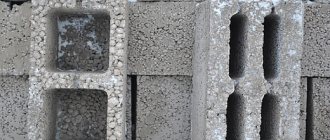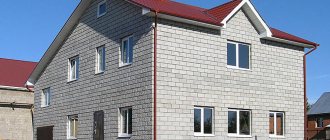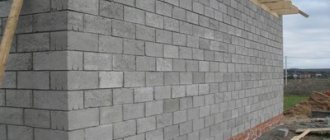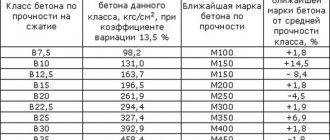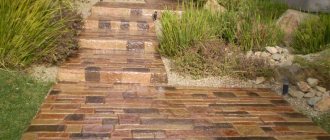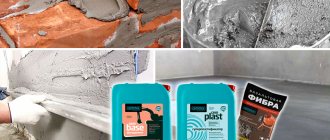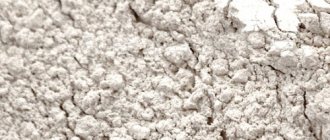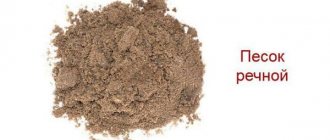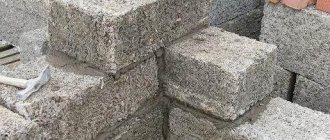- 1 How to choose ingredients for expanded clay concrete composition?
- 2 Approximate ratio of ingredients
- 3 Floor mixture recipe
- 4 Expanded clay concrete for walls
- 5 Recipe for lightweight expanded clay concrete
- 6 Let's summarize
Expanded clay concrete is a very popular material in the construction industry. It has a lot of positive properties that help make the building suitable for use in accordance with all operating rules, and is in no way inferior in this regard to other types of concrete. What is this material? What components are included in expanded clay concrete? In what proportions are the ingredients mixed per 1 m3? The answers can be found below.
How to choose ingredients for expanded clay concrete composition?
It is not difficult to prepare expanded clay concrete mortar. This building material contains high quality cement and fine expanded clay, made from exclusively natural raw materials. For greater density, sand is mixed into the solution. Sawdust or ash can also be added.
The proportion of the material can be compiled directly on the construction site. Professionals in this matter give several recommendations that should not be neglected:
- When preparing the mixture, take into account the quality characteristics of the raw materials used: humidity, grain size;
- If you want to increase the strength and elasticity of the future building material, add quartz sand during mixing. In this case, expanded clay gravel is acceptable without expanded clay sand and moisture-sensitive cement, the addition of which usually makes the finished structure vulnerable to moisture;
- as a binder, as a rule, Portland cement with a minimum marking of M400 is used, which does not have plasticizing components that provoke a decrease in the strength of the finished product at the initial stages;
- The strength of the finished product can be increased by adding cement to the composition of expanded clay concrete. However, this leads to an increase in the volumetric mass of the building mixture;
- if heat treatment of expanded clay concrete material is planned, then preparation should be carried out from alite cement;
- to work with solid expanded clay concrete, more expanded clay is added inside the solution.
The density and structure of the finished blocks, which are:
- large porous;
- with intergranular pores;
- coarse- and fine-grained;
- quite dense;
- with medium thickness.
For a mixture with moderate density, coarse expanded clay is used. Such a solution often acts as a heat insulator. Fine expanded clay is used in the construction of load-bearing structures and interior walls. It is used to produce expanded clay concrete monoliths of various sizes, marked M50, M75, M100.
The smaller the expanded clay granules, the denser and heavier the finished material will be. In this case, its thermal insulation properties are lost. Therefore, in order to achieve a golden mean, manufacturers of expanded clay concrete building materials often combine small and large expanded clay.
Return to contents
Advantages and disadvantages
To determine the advantages and disadvantages, you should pay attention to the main characteristics of expanded clay concrete. The choice of material for solving specific construction problems depends on them.
Among the main advantages, the following should be highlighted :
- Small mass of finished products. Due to the porous structure of expanded clay, the material has a low density. For buildings made of expanded clay concrete blocks, there is no need to build a bulky foundation designed for high loads. Self-assembly of lightweight blocks significantly reduces overall labor costs and shortens construction time.
- Acceptable strength. Expanded clay concrete can be used for the construction of load-bearing walls and floors, since its strength is slightly inferior to classic concrete.
- Good thermal insulation properties. Expanded clay concrete walls and floors ensure heat retention in the room much better than those made of classic concrete.
- Excellent sound insulation. This characteristic is especially important when using the material for the construction of a residential building. The premises will be well protected from street noise.
- Environmentally friendly. This advantage is due to the use of expanded clay obtained from clay as a filler. All components of the composition do not emit harmful substances into the atmosphere.
- Durability. Expanded clay concrete has been used in construction for quite some time. Over the entire period of use, it has established itself as a reliable material that can last for many decades.
- Low cost. Due to the low cost of expanded clay, the material can be considered one of the cheapest options for producing a concrete mixture.
- Ease of manufacture and prevalence. The simple technology of block production has led to the widespread proliferation of small-scale production. In this regard, the material can be purchased even in small towns, which will provide additional savings.
- Easy finishing work. The surface of expanded clay concrete is characterized by high adhesion. Plaster mixtures of any composition adhere perfectly to it.
READ Characteristics and scope of use of M100 concrete
Some features of expanded clay concrete create certain restrictions in use. The main disadvantage of the material is considered to be high moisture permeability and increased water absorption. Moisture is actively absorbed by the porous structure of expanded clay. This property is especially dangerous at low temperatures, when the accumulated liquid begins to crystallize and can lead to the formation of cracks. For this reason, such building materials can only be used in structures insulated from weather influences. If the material is used for the construction of external walls, careful waterproofing is necessary.
Minor disadvantages include the need for additional thermal insulation. Despite the good thermal insulation properties of the material, buildings made of expanded clay concrete require insulation of external walls.
Approximate ratio of ingredients
When producing expanded clay concrete mixtures for the construction of private houses, the following generally accepted proportions of added components, calculated for the M400 cement grade, are practiced:
- expanded clay – 4-5 buckets (depending on the grain size);
- sand - 3-4 buckets;
- cement - 1 bucket;
- water – 1.5 buckets (approximately);
- plasticizer - based on the instructions for this ingredient.
The finer the expanded clay, the more it is added, and the higher the density of the solution will be.
If the plasticizer is liquid soap, then 2-3 caps of a five-liter plastic tank are mixed with the above amount of cement - this comes out to about 100 g.
When pouring water, be guided by the condition and appearance of the solution. It should be buoyant and at the same time viscous. You can check the condition of the mixture like this. Scoop it out with a shovel. If a fairly stable mound has formed on the shovel, the solution is good; if the mound spreads quickly, the material is too liquid.
Return to contents
Application options
Expanded clay concrete has become widespread in construction.
The most popular two ways to use it :
- For making brick blocks.
- To create a self-leveling floor, that is, screed construction.
It should not be confusing that the blocks are called brick. Bricks are building elements of a given shape from which masonry is constructed. The material of manufacture does not matter. Thus, any building blocks can be called bricks.
Occasionally, expanded clay concrete is also used for the construction of monolithic walls. This may be required in buildings with timber floors, as reducing wall mass is a priority.
Making blocks
To save on purchasing ready-made blocks, you can make expanded clay concrete with your own hands.
The proportions of the components may vary slightly, but the following recipe is the most popular: one part of cement; two or three parts of sand; one part water; three to five parts of expanded clay. To make the solution, it is recommended to use a concrete mixer; it will greatly simplify mixing. The sequence of mixing the components is of great importance :
- Cement is first loaded into the concrete mixer or mixing bin. Sand is added to it. These bulk components must be thoroughly mixed.
- Water is gradually added to the resulting mixture, the composition is mixed until a homogeneous consistency is obtained.
- At the final stage, expanded clay is introduced into the cement mortar. The mixture is stirred until the filler is evenly distributed.
READ Characteristics and scope of concrete grade M450
Expanded clay is extremely hygroscopic. It absorbs moisture so actively that sometimes the mixture can become almost dry. It is not possible to use it in this state, so you need to add a small amount of water. You should only achieve complete coverage of the expanded clay surface with cement mortar. It is impossible to bring the mixture to a liquid consistency, otherwise the formation of the future block will be disrupted, it may crumble when removed from the mold or will have serious defects.
The resulting solution is placed in pre-prepared molds. It is necessary to ensure that the molds are completely filled to prevent the formation of voids in the finished product.
To simplify the preparation of the mixture, it is not necessary to purchase cement and sand separately. A ready-made dry mixture called sand concrete is available for sale. It is recommended to use grade M-300 and higher, this will ensure sufficient strength for the finished blocks.
Performing a screed
The self-leveling floor installation involves the use of a liquid mixture.
To prepare it, mix:
- one part cement;
- three parts sand;
- one or two parts of water;
- two parts of expanded clay.
The indicated amount of water can be considered basic. During the mixing process, expanded clay will actively absorb liquid. Water can be added until the consistency of liquid sour cream is obtained. The solution is prepared and mixed in the same sequence as recommended for making blocks.
There are additional conditions that must be met before applying the solution. The concrete floor slab should not come into contact with moisture. Dry concrete or other base material should not be allowed to absorb water. This requires mandatory waterproofing. It is best to use special ready-made formulations that are commercially available for these purposes. They are usually produced in the form of mastics or emulsions. A waterproofing agent applied to the base in advance will ensure proper hardening of the mixture to form a monolithic structure.
After a couple of days, the solution will harden sufficiently. After this, you can begin applying the finishing layer. The top layer is formed from a cement-sand mixture. For convenience, you can use ready-made sand concrete. The consistency of the solution should resemble slightly softened butter. Excess liquid should be avoided. The recommended amount of water is usually indicated in the instructions for use.
The solidity of the screed is achieved after several days. To increase strength, it is recommended to maintain a wet state for a month. To do this, the floor can be lightly sprayed with water or simply covered with plastic wrap.
Floor mixture recipe
Depending on the method of pouring the flooring, expanded clay concrete floor screeds can be dry, semi-dry, or wet. For wet floor screed, the following proportions of expanded clay concrete are used: 4:3:1 – expanded clay/sand/cement. Expanded clay concrete mixture grade M100 is made with this proportion.
Return to contents
Recipe for lightweight expanded clay concrete
As is already known, the smaller the granules of expanded clay used, the denser the final material will be. The specific gravity of light grades of mortar can reach 1000 kg/m³. At the same time, the presence of cement inside the mixture is reduced, and expanded clay, on the contrary, increases. There may be no sand here at all. For a sandless mixture, based on 1 m3, the following proportions are used:
- 720 kg of expanded clay brand M200;
- 250 kg of cement sand;
- 100-150 liters of water.
Return to contents
